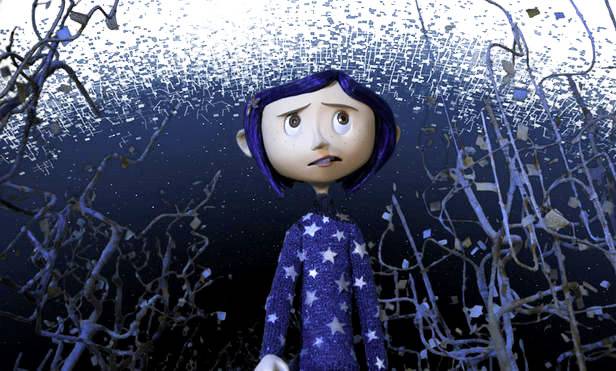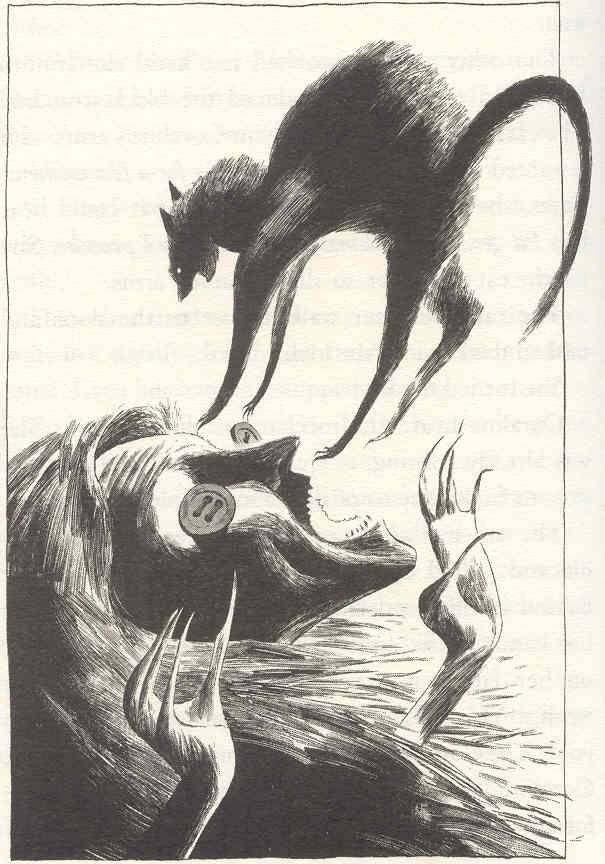 Diehard fans of the Newbery-winning Neil Gaiman want to know one thing about the film adaptation of Coraline: is the movie as good as the book? My response to this is also a question: how could it be? While director and adapter Henry Selick created a dazzling world suitable for Neil’s vision, the film can only fall short of what the imagination is capable of. Coraline, the novella, is a sparse, downright chilling fairy tale, while Henry Selick’s movie is a masterpiece of art that only touches on the elements that made the book so wonderful.
Diehard fans of the Newbery-winning Neil Gaiman want to know one thing about the film adaptation of Coraline: is the movie as good as the book? My response to this is also a question: how could it be? While director and adapter Henry Selick created a dazzling world suitable for Neil’s vision, the film can only fall short of what the imagination is capable of. Coraline, the novella, is a sparse, downright chilling fairy tale, while Henry Selick’s movie is a masterpiece of art that only touches on the elements that made the book so wonderful.
The framework of the story is preserved for the big screen: a girl moves into an apartment with her parents in a huge Victorian house. One day, Coraline gets bored and ends up finding a door that’s bricked up on the other side. But when she unlocks it alone, the door leads to a parallel world very much like her own, only with skewed differences; unlike her real home, she’s given every bit of attention she wants, and here the food is amazing, unlike her father’s recipes. Every turn is full of interesting, eye-popping flora or entertainment, a far cry from her boring home. But she also has “other” parents in this world, and they kind of creep her out with those black button eyes. Coraline’s other parents want her to stay with them forever-they’ve even offered her a set of her own button eyes. Suddenly, the other world doesn’t seem so innocent and wonderful… and her other mother becomes quite insistent Coraline never leaves her again.
My dual personalities (I majored in both art and fiction writing) are at a loss with how to respond to Henry Selick’s adaptation. On one hand, I am marveling at the intricate, gorgeous details of the sets and puppets – more than any other film you’re likely to see, Coraline is a masterpiece of art. It’s the first stop-motion film shot entirely in 3D, but what blows my mind is the fact it is an utterly handmade movie, from the flowers and the puppets, down to Coraline’s tiny blue boots. Every detail of the film was either hand-stitched with tiny needles, or pieced together with found objects: one featurette of Coraline listed in Neil’s blog talks about how a rubber urchin-like dog toy served as the foundation to make one of the thousands of handmade flowers in the backdrop. The folks at Laika, who made the film from scratch, are wizards of ingenuity and their use of detail. I admittedly wasn’t a fan of 3D films going in, but Coraline pops off the screen in a visceral way, almost disappearing in the flow of the film, creating a perfect marriage between stop-motion animation and 3D. The film bypasses common 3D clichés, opting to wow us through realistic raindrops running down a windowpane than make us jump from something shooting out the screen (though in the opening credits, there is that very close call with a large needle). The effect breathes further life into the very real details of the sets and puppets. By contrast, the 3D update to Selick’s cult stop-motion film, The Nightmare Before Christmas, was much less impressive. The effect in Coraline is mesmerizing, and in terms of film production, should not be missed on the big screen.
 But then there’s the purist in me, the writer’s side, the fan of Neil’s novella that can’t let go of one big change to the original story: why the addition of the character “Wybie?” The aptly-named (his name is short for “Why Born”) distraction to Coraline is a grating hiccup in the tone of the film, a very distinctly non-Neil creation that would’ve annoyed me even if I hadn’t read the book before viewing the film. I could’ve relented to the fact a movie can very seldom transfer the wonderful elements of a good book to the screen, I could’ve understood that the scariness of Neil’s novella was overridden by the distracting rainbow that is the look of the film, but I cannot, I cannot, understand why the need for this new, out-of-place character.
But then there’s the purist in me, the writer’s side, the fan of Neil’s novella that can’t let go of one big change to the original story: why the addition of the character “Wybie?” The aptly-named (his name is short for “Why Born”) distraction to Coraline is a grating hiccup in the tone of the film, a very distinctly non-Neil creation that would’ve annoyed me even if I hadn’t read the book before viewing the film. I could’ve relented to the fact a movie can very seldom transfer the wonderful elements of a good book to the screen, I could’ve understood that the scariness of Neil’s novella was overridden by the distracting rainbow that is the look of the film, but I cannot, I cannot, understand why the need for this new, out-of-place character.
Strangely enough, this was the exact problem with the adaptation of Neil’s last novel to make it to the big screen, Stardust. There was no cross-dressing pirate, nor any flying pirates, in the novel. And telling enough, Robert DeNiro’s flamboyant pirate scene was the overwhelming core of many critics’ criticisms with the film. Why must filmmakers insist they know how to weave a story better than a multiple award-winning author? If it ain’t broken, folks, don’t fix it.
It’s true the novella is better than the film, but that is a testament to the book’s greatness. Henry Selick’s movie is marvelous on its own, if you never knew it was a book to begin with. See Coraline on the big screen in 3D, because you’ve never seen anything quite like it. For those who have not read the book, I urge you to watch the film first, so that you may enjoy its sheer beauty without comparing it to the novella. Afterwards, sit down and let yourself be haunted by Neil Gaiman‘s words. I promise you, Neil himself will not disappoint.








